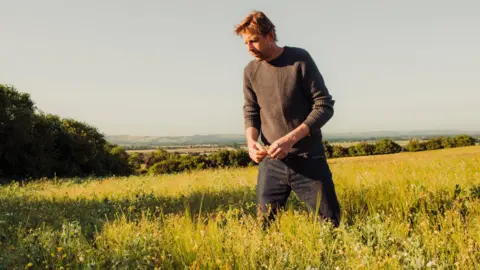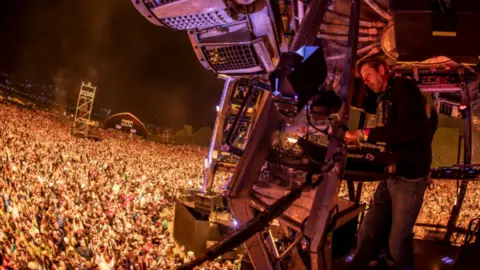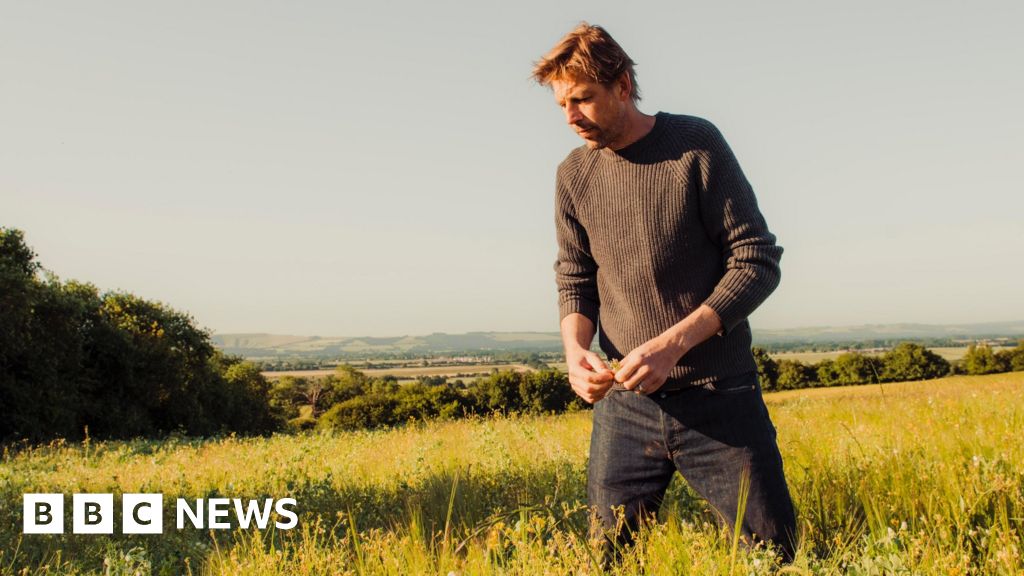By Aleks Phillips, BBC News
 Wildfarmed
WildfarmedAs one half of Groove Armada, Andy Cato has been an electronic music star for nearly three decades. But he has never been asked for as many selfies as he has since appearing on the latest series of Jeremy Clarkson’s farming show.
He did not go on Clarkson’s Farm – which follows the presenter as he grapples with running his Oxfordshire farm – for renewed fame. Rather, his aim was to expose its audience to his passion: regenerative farming.
That is, moving towards a food system powered by biology rather than by chemistry, as he puts it.
Regenerative farming seeks to reverse the biodiversity loss that modern farming can cause with fertilisers and pesticides by changing how crops are managed.
On the hit Amazon Prime docu-series, Cato is invited onto Clarkson’s Diddly Squat farm – so named because it makes him very little money – to take over one of the fields and demonstrate these nature-driven methods.
The experiment was a success, and he has won over the former Top Gear presenter.
“We started filming the next series a month ago now, and he wants to expand the area where we’re embracing these techniques,” Cato tells the BBC. “So yeah, I think we got off to a good start.”
While modern farming practices allow for the same fields to be used year after year to produce enough crops to feed consumers, they can remove organic content from fields, meaning farmers must add chemical fertilisers to sustain their crops.
This can be costly for farmers and some scientists say it means the microbes and organic compounds that make healthy soil and nutrient-rich food are not necessarily being replenished, ultimately diminishing the ability of farmland to grow crops.
Regenerative farming aims to reintroduce microbes, nutrients and carbon back into the soil.
Some ways of doing this – which are already being taken up by farmers in the UK, India and elsewhere – include planting different crops side by side and sowing cover crops, which cover the soil in between harvests to retain its organic content.
In the latest series of Clarkson’s Farm, Cato oversees the planting of two crops, wheat and beans, in the same field, rather than the traditional single crop.
He says this is so the field can still be used to produce grain, with the beans providing some of the nitrogen needed to fertilise the soil.
 Prime Video
Prime VideoWhile this meant the yield of each was lower than if he had planted just one crop, Cato says this was compensated for by not having to pay for the 300kg of nitrogen usually needed to add artificially to the field.
Much of Clarkson’s Farm is devoted to showing how upfront costs – such as feed, energy and fertiliser – can make farming a risky and often unprofitable profession. The government estimates that these made up nearly 70% of farmers’ expenses in 2023.
The price of feed and fertiliser has also fluctuated dramatically in the past few years due to the war in Ukraine and energy price rises, while unpredictable weather has affected the quality – and therefore the value – of crops.
“To all of the traditional risk that farmers have been shouldering for decades, we’re now adding massive climatic volatility and massive price volatility – and it’s just not a reasonable ask,” Cato says. “We just can’t keep doing this, and farmers won’t keep doing this.”
Using fertilisers and pesticides can also be costly for the environment – as they can kill off native species and leach into waterways.
Cato says that he is currently running a pilot in which water companies pay farmers to adopt regenerative farming techniques, “because it’s a lot cheaper [for them] – keeping the nitrates and the pesticides out of the river than getting them out afterwards”.
But he admits the switch to regenerative farming can be challenging, as while it is “getting biology and nature to do more of the work… you’re replacing a largely prescribed set of fertilization and treatments with observation and reaction”.
Soil is tested regularly and the nutrients added to the field adjusted according to what it is lacking.
Putting this careful balance across in a TV show was “complicated and leads towards insomnia”, he says.
Joe Stanley, a regenerative farmer and member of the National Farmers’ Union environment forum, agrees that these techniques “require more attention to detail [and] probably more time and effort”.
There are other potential trade-offs. While modern agriculture uses machinery to minimise labour costs, he says regenerative farming would likely require a larger workforce – which could raise food prices. But Mr Stanley argues retailers could also absorb this cost.
“That’s one of the big problems of the transition to sustainable farming: how do we pay a fair price to the farmer for food which may be more expensive to produce?”
Mr Stanley says harvesting two different crops from the same field can produce a higher combined yield, but also creates the cost of then sorting those two crops – something Cato’s company covers.
Lizzie Sagoo of agricultural consultancy Adas, who specialises in soil and crops, says that while techniques like cover crops provide a “suite of benefits” including improved yields, this would likely be outweighed by the cost of cultivating a crop farmers cannot harvest – requiring a further financial incentive.
Cato also thinks that, despite the benefits of regenerative farming, the transition should not be put solely on farmers’ shoulders as “they’re absolutely at the financial edge already.”
The UK government currently offers farmers £129 per hectare of cover crops. And in May, Waitrose announced it would be offering financial assistance to farmers to convert, so its fresh produce was regeneratively farmed by 2035.
 Charlie Raven
Charlie RavenSo what inspired Cato to trade in his synthesizer for a muck spreader?
He says it began with reading an article about the environmental consequences of food production on the way back from a gig.
“It didn’t paint a pretty picture. And it ended with the line: ‘If you don’t like the system, don’t depend on it.’ That line got me into buying books on self-sufficiency and trying to grow vegetables where we were living at the time in France.”
It was in France that he sold his publishing rights to establish his first farm using regenerative practices – despite having no background in agriculture.
This lack of farming heritage was picked up on by Kaleb Cooper, Diddly Squat’s local boy turned farm manager. In what Cato describes as “without question the line of the series”, the money-conscious Kaleb acerbically remarks: “Was you in a band? I can tell because you’ve left your tractor running at a pound per litre.”
Cato says it was ironic as, when he lived in France, he was the only one in the area who would turn his engine off.
“Because I’ve spent my life in noise, it drove me insane,” he explains. “So in France I was known [as] the annoying person who always turned their tractor off. But I got totally bested by Kaleb there, so I just need to wear that one.”
Cato moved back to the UK and now 110 farms across the two countries are part of his regenerative farming movement – though he sees the number growing as “one of the things that needs to be challenged in that is the assumption that business as usual is an option”.
The Global Environment Facility estimates that, due to a number of factors including farming practices, 95% of the world’s land could become degraded by 2050, making it unable to sustain crops at yields needed for consumption.
Experts have warned that without efforts to combat soil degradation, there would only be a limited number of harvests left.
But Cato remains hopeful that this is not a foregone conclusion.
“If you give nature half a chance, it comes roaring back,” he says. “When you see those plants poking their way through a crack in the pavement, you know it has immense power… The speed of recovery if we get these things right is really profound.”


